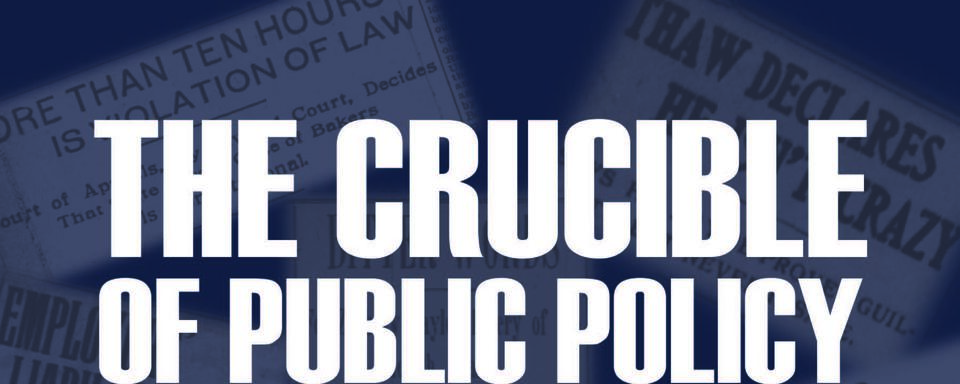
Some Things I Learned About Courts From Writing The Crucible of Public Policy
Guest post by Bruce W. Dearstyne.
Courts are much in the news these days, e.g., tumult over Supreme Court’s recent rulings on abortion, gun control and other issues and the process of selecting a new Chief Judge of the New York Court of Appeals. People realize that there is much at stake, because courts, particularly the state’s and nation’s highest courts, are the final arbiters of crucial public policy issues. Their decisions have far-reaching consequences for our lives. Research for my book The Crucible of Public Policy: New York Courts in the Progressive Era, published by SUNY Press in 2022, gave me new insight into how high courts actually work.
During much of our history, state courts have been more important than federal courts. Most of the key social, economic, political and constitutional issues were settled at the state level. Litigation in the federal court system, commonplace today, was in the past more limited. Appeals to the U.S. Supreme Court were apparently more rare than today.
The State Constitution counts. In the past, the Court of Appeals was inclined to cite provisions of the New York State Constitution alongside those of the U.S. Constitution. Now, that seems less common.
Judges consider lots of factors and issues in deciding key cases. I did not realize how much information the Court of Appeals has before it in deciding cases, including the State and U.S. Constitutions; decisions of the state supreme and appellate courts on the cases before they reached the high court; lengthy briefs and oral arguments by attorneys for both sides of the issues at hand; sometimes, so-called “amicus” briefs by interested third parties (the term comes from these people representing themselves as “friends of the court” desiring to enlighten the judges); previous decisions of the Court of Appeals and Supreme Court and occasionally other courts (e.g., highest courts in other states); sometimes, law books and law journal articles; and possibly other material. Some of the cases I researched had over a thousand pages of material for the judges to consider. I suspect that is on the low side today for some high-stakes cases.
Judges balance precedent and innovation. The period covered by my book, ca. 1900-1920 was, much like today, a time of vast social changes and political tensions. In deciding cases, the Court of Appeals sometimes interpreted the constitutions narrowly and clung to the precedent of past court decisions – the legal doctrine of “Stare Decisis,” a Latin term that means “let the decision stand.” But more often, the court looked for ways to interpret the constitutions in light of contemporary life, thereby keeping them fresh and relevant while adhering to their principles and the limits they set, and approved leading-edge legislation.
Courts sometimes make tough calls when legislatures have not. Alton B. Parker, New York’s Chief Judge from 1897 to 1904, felt that some state legislatures passed too many laws. They were trying to satisfy various constituencies and sometimes the resulting laws were hastily or poorly written. It fell to the courts to declare them unconstitutional, thereby incurring the criticism of the groups that had lobbied to have them passed. On the other hand, sometimes the court decisions provided guidance for legislators writing replacement laws, which were better than the ones the courts had struck down. In still other instances, legislatures avoided dealing with issues in the hope that the courts would address them through what is sometimes called “common law” or “judge-made law.” Sometimes, that happened. Sometimes not, and the issue bounced back to the legislature for attention.
Court opinions have multiple audiences. The courts decide the cases and explain their reasons. If it is a divided decision (as may were in my period, and many are today), there is a majority and one or more minority opinions. There may also be concurring opinions reinforcing the majority or minority views. But, beyond that, I came to realize, the courts are not just aiming at the parties to the case. They are also aiming at legislators, the media and the general public. Some decisions are laden with legal jargon but the best ones are clear, distinct, and direct. Hence, advice I sometimes offer people about controversial decisions these days: read the decision for yourself. Don’t just rely on interpretations by reporters, pundits, partisans or others.
Courts can seem arbitrary but usually they are not. The period I covered, the early 20th century, was the one that first saw media and political criticism of the courts for controversial decisions. The criticism in those days was, for the most part, mild and measured. Criticism today is much less restrained. It is useful to keep in mind that court decisions are collective ones, reached after careful discussion among the judges where conflicting perspectives are aired and alternative outcomes proposed. Individual judges try out proposed opinions, listen to each other to gain insights, and hold discussions that may sometimes border on debates. Courts are well aware of the importance and consequences of their roles. They expect scrutiny of their decisions. They weigh and balance lots of factors. They recognize the need to explain the basis for the decisions. Sometimes, this results in arbitrary, biased decisions. But usually it results in decisions that are reasonably balanced and carefully explained even if that does not align with various groups’ views of what they think the court should have done.
Bruce W. Dearstyne is a historian specializing in New York history. SUNY Press published the second edition of his book The Spirit of New York: Defining Events in the Empire State's History and his newest book The Crucible of Public Policy: New York Courts in the Progressive Era in 2022.

